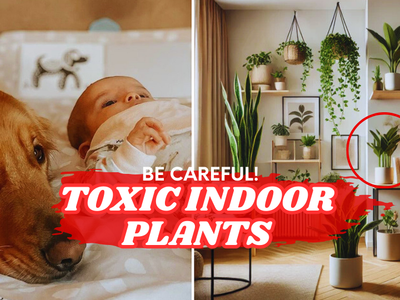The 5 most toxic indoor plants
Toxic indoor plants are not only dangerous for pets. Children also like to put parts of plants in their mouths. If you don't want to take any risks, you should avoid the following five indoor plants.
Indoor plants improve our indoor air quality, add color and bring a soothing calm to the room. However, what many people don't know is that some of the most popular houseplants are toxic and are a serious danger to babies, toddlers and pets. They are also not always suitable as plants for the bedroom. We present the five most toxic indoor plants.
1. Spath
As beautiful as the Spath (Spathiphyllum floribundum) is, it is also dangerous. This indoor plant, which belongs to the arum family, contains toxic substances, as does the calla (Zantedeschia), which is also part of the same family. Contact with the plant's sap can cause unpleasant skin irritation. If parts of the plant are eaten, it can cause swelling of the mucous membranes, cramps and stomach and intestinal problems.
2. Cyclamen
Room cyclamen (Cyclamen) grace many a windowsill with their colorful flowers, especially in winter. But even if you can't tell from the pretty flowers: the wild form contains, among other things, the eponymous cyclamine, a very toxic saponin, in its root bulb. In addition to cramps, diarrhea and vomiting, it can cause severe circulatory disorders and even fatal respiratory paralysis.
3. Amaryllis
Year after year, the amaryllis, also known as the “knight star”, impresses with its large exotic flowers and is particularly popular at Christmas time. However, it should not be underestimated! All parts of the plant are toxic, especially its bulb. If the amaryllis bulb is mistaken for an edible one and consumed, severe symptoms of poisoning can be expected. Even small amounts can be fatal. Almost immediately after ingestion, gastrointestinal complaints and disturbances of brain function can occur, including complete paralysis of the brain.
4. Azaleas
House azaleas are also among the toxic indoor plants, although they are considered to be less toxic. It is not sufficiently known at what point a dose is critical, but eating just one leaf or flower is enough to cause the first symptoms of poisoning. The symptoms include increased salivation, nausea and gastrointestinal complaints. These are accompanied by sensory disturbances in the limbs.
5. Kalanchoe
Kalanchoe Flame Katka is probably the best-known variety of this plant. It is a classic houseplant and a popular Mother's Day gift. However, some varieties should not be kept in households with pets. The poisonous leaves are particularly dangerous for cats. They contain malic and isocitric acid, which are not at all good for our feline friends and can cause spastic muscle cramps, vomiting or cardiovascular problems.

